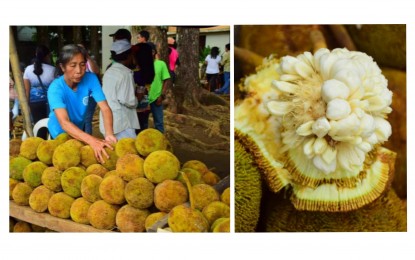
MARANG FESTIVAL. Sweet marang fruits are being sold in this week’s return of the Marang Festival in Barangay Colonia Divina of Sagay City, Negros Occidental on Tuesday (Sept. 12, 2023). About 3,000 kilos of marang were displayed during the opening event. (Photo courtesy of Sagay City Information and Tourism Office)
BACOLOD CITY – The upland barangay of Colonia Divina in Sagay City, northern Negros Occidental, where close to 100,000 marang trees are being grown, is being geared by the local government to become the “Marang Capital of the Philippines.”
This week, the village again held the Marang Festival after a three-year hiatus due to the coronavirus disease 2019 pandemic.
Helen Cutillar, city information and tourism officer, said on Friday efforts continue to boost yield amid the challenges posed by climate change to ensure sustained production of the sweet tropical fruit.
The festival’s fifth edition on Sept. 12 with about 3,000 kilos of marang fruits on display, is themed “Balik Marang Festival, Balik Pasalamat kag Sinadya” to celebrate its return amid this year’s bountiful harvest.
Governor Eugenio Jose Lacson and Mayor Narciso Javelosa Jr. led the kick-off, which featured an “eat-all-you-can” event and an array of delicacies made from marang.
“It is just fitting to celebrate the festival in the barangay where almost 100,00 marang trees bear tons of fruits during harvest season. It is only in Sagay where one can taste the sweetest marang in Negros Occidental. I believe the day will come that we will be known as the ‘Marang Capital of the Philippines’,” Lacson said.
Javelosa committed to assisting in the improvement of agriculture in Colonia Divina to make it an agri-tourism destination of the city.
Village chief Johnny Buhayan said this year, farmers have an estimated daily harvest of 3,000 kilos since the first week of August, much higher compared to last year’s yield.
Aside from selling the fruits, residents also make sweet delicacies from marang such as jam, spread, piaya, pastillas, tarts, and ice cream.
“Create more value-added products to the fruit to elevate your livelihood and generate more income,” Lacson told the marang farmers.
The governor said the city government can coordinate with the province’s Technology and Livelihood Development Center to help the farmers create and market more products from marang.
City Agriculturist Julie Delima said that Colonia Divina produces sweeter marang fruit because of its red fertile soil and cold weather.
“Bats that abound in the area add more nutrients to the soil coming from their droppings,” she added.
Data on the history of Barangay Colonia Divina provided by the city government showed that marang fruit tree seedlings were brought by followers of the trinitarian religion, Alaph Divine, led by Dr. Roberto Mahilum, who settled in the upland part of Sagay, which he called “divine colony,” in 1957.
It added that based on the recollection of former village chief Nicasio Buhayan Sr., these people came from various places in Negros, Cebu, Guimaras, Capiz, Iloilo, and other parts of Panay Island. (PNA)
